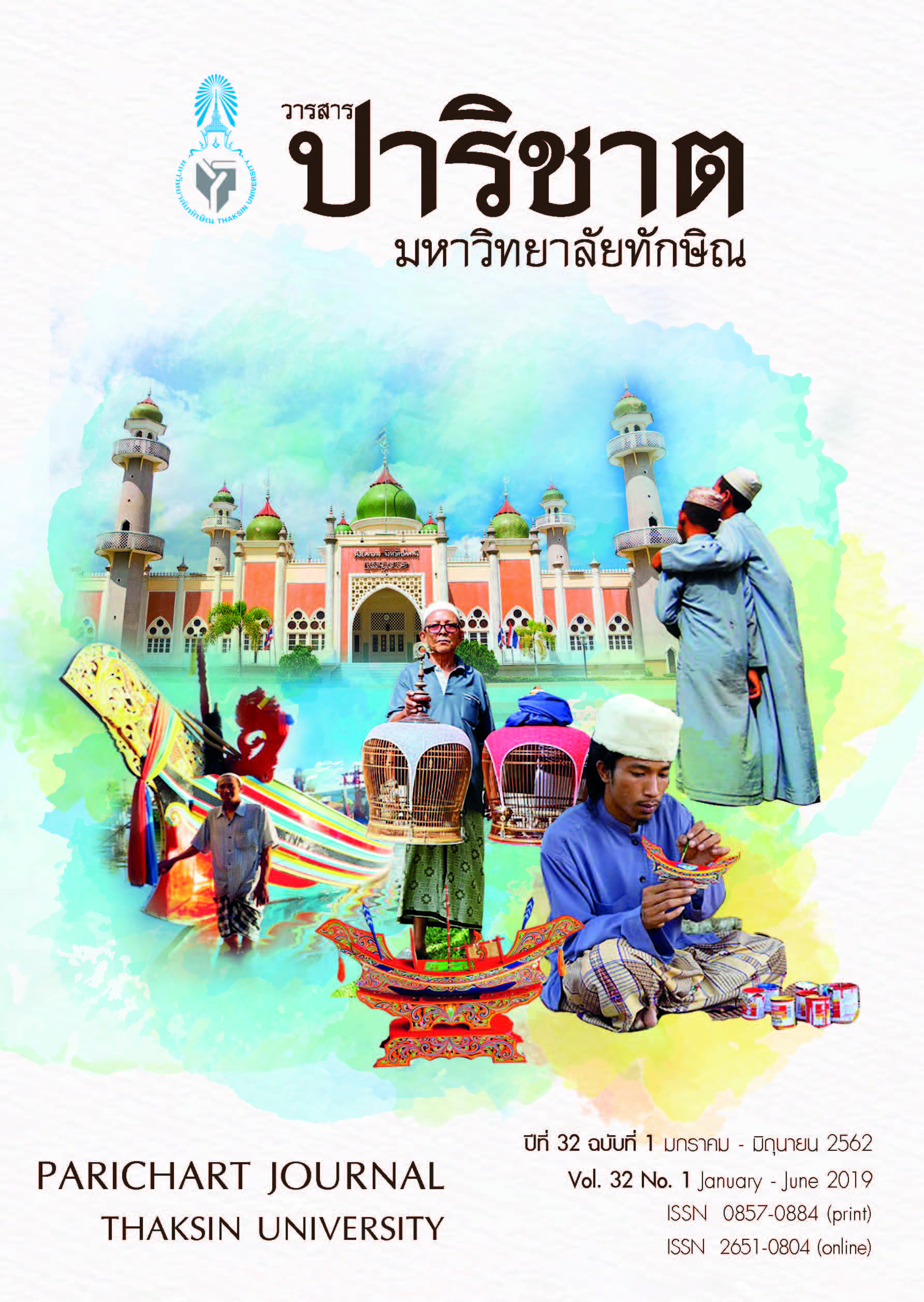Strategies for Trang Province Tourism Potential Development
Main Article Content
Abstract
The objectives of this study were 1) to analyze the internal and external environment of Trang Province tourism and 2) to determine the strategies for the development of Trang Province tourism potential. The mixed methods approach was applied as the research design, and in-depth interview was used as the instrument to gather the relevant data from 22 samples. Furthermore, the content analysis, SWOT analysis and TOWS matrix synthesis were used to analyze the collected data. Another data collection method was a questionnaire which was employed to collect the data from 400 samples, and the data were quantified and analyzed using the descriptive statistics to examine values of Mean and Standard Deviation. The results of this study indicated that the strategies for Trang Province tourism potential development consisted of 5 significant strategies: 1 ) development of infrastructures and facilities to promote international tourism, 2) development and evolution of integrated sustainable attractions, 3)development of value-added products and services, 4)establishment of reliability and increase of international tourism opportunities, and 5) development of human resources and improvement of tourism network relationship.
Article Details
References
Kamali, M. H. (2011). Tourism and the Halal Industy: A Global Shariah Perspective in the World Islamic Tourism Forum 2011, unpaged. 12-13 July 2011 the Global Islamic Tourism Organisation (GITO) Malaysia and the International Institute of Advanced Islamic Studies (IAIS). Kuala Lumpur Malaysia: the International Institute of Advanced Islamic Studies (IAIS).
Kwanmeuang, J., Thanarat, V., Ramnoo, D., & Preedasuttijit, R. (2014). Definition and Importance of the Tourism Industry. Chonburi: Burapa University. Retrieved on November 30, 2016, from https://tourismatbuu.wordpress.com.
Homcheun, S. (2012). World Tourism Situation Report 2030. Bangkok: TT Review Magazine. Retrieved on February 27, 2016, from https://www.tatreviewmagazine.com/mobile/index.php/menu-read-web-etatjournal/menu-2 0 1 2 / menu-2 0 1 2 -janmar/62-12555-conference-future-tourism.
Regional News Team. (2017). “Tourism 2017” to Revive Thai economy. Bangkok: Thairath Newspaper. Retrieved on March 9, 2560, from https://www.thairath.co.th/content/825285.
Trang Office. (2013). Development Plan for Trang Province 2014-2017. Trang: n.p.
Tourism Authority of Thailand. (2015). Tourism Authority of Thailand Info. Bangkok: Tourism Authority of Thailand. Retrieved on February 27, 2016, from https://www.tatnewsthai.org/detail.php?newsID=3759.
Department of Tourism. (2015). Domestic Tourist Arrivals in 2014 by Region. Bangkok: Department of Tourism. Retrieved on February 27, 2016, from https://www.tourism.go.th/home/details/11/221/24333.
Varakulwit, S. (2008). Orientation of Tourism Industry. Bangkok: Sam Lada.
Ganhajan, T. (2015, June 19). “The carrying capacity of tourism potential in Trang”, Banmuang. 15.
Bouchume, K. (2009). Potential of Palian Sub-District, Trang Province for Tourist Attractions. Independent Study.Khonkaen: Khonkaen University.
Trang Office. (2009), Trang Development Plan 2010-2013. Trang: n.p.
Kanyook, M., Khunweechuay, M., Naka, T., & Deeprom, N. (2009). The Potential of the Marine Sustainable Tourism Products and the Sustainable Tourism Trend on Seacoast and Island, and Tourist Behavior in Three Marine Areas: Andaman Sea, Songkhla Lake, and the Gulf of Thailand. Research report. Bangkok: The Thailand Research Fund.
Chuaybamrung, T. (2009). Koh Chang... Marine Travel on Knowledge Base. Research Report. Bangkok: The Thailand Research Fund.
Buhalis, D. (2000). Marketing the Competitive Destination of the Future. Tourism Management, 21(1), 50-51.
Chunhapandarak, C. (2001). Business Policy and Strategic Management (3rd Ed.). Bangkok: Documentation Center and Suan Dusit Rajabhat Institute.
Saengpikul, A. (2013). Research Methods in Tourism and Hospitality. Bangkok: Dhurakij Pundit University.
Miles, M.B., & Huberman, A.M. (1994). Qualitative Data Analysis. Thousand Oaks, CA: Sage.
Humphrey, A. (1960). SWOT. Retrieved on March 16, 2016, from https://adisonx.blogspot.com/2012/10/ swot-analysis.html.
Tittiekarat, T. (2010). Satisfaction in the Control of Safety in Life and Property and the Loyalty of Tourists in Trang Province. Independent study. Phitsanulok: Naresuan University.
Thaothampitak, W., & Weerakit, N. (2012). Tourist motivation and satisfaction: The case study of Trang Province, Thailand. Research Report. Phuket: Prince of Songkhla University.
Mangruengsakul, P. (2012). The Strategies for Sustainable Tourism Development of Nakhonrachasima Province. Doctoral Dissertation. Pathumthani: Valayaalongkorn Rajabhat University.
Noonta, A. (2011). Guidelines for Tourism Development at Pakmeng Beach, Sikao District, Trang Province. Independent Study. Khonkaen: Khonkaen University.
Rugkhaphan, S. (2010). The Learning Sites for the Community Based Tourism Planning: A Case Study of the Network of Trang Basin Community Organization/NTBC, Trang Province. Master Thesis. Songkhla: Thaksin University.
Wattanaporn, S. (2012). Integrated Strategic Management of Tourism in the Samutsakhon Province. Doctoral dissertation. Bangkok: Sripatum University.
Sritawee, J. (2010). Roles of the Tourist Guide Participation on the Environment Preservation for Tourism in Changwat Trang and Satun. Independent Study. Songkhla: Prince of Songkla University.
] Kunpalin, P. (2 0 0 7 ). Development Administration in Bangkok Metropolitan Area: A Study of the Integrated Tourism Strategies. Doctoral Dissertation. Bangkok: Ramkhamhaeng University.
Phuwanatwichai, T. (2010). Integrated Strategic Planning of Tourism Development on The R3A Northern Economic Corridor (Chiang Rai-Kunming). Doctoral Dissertation. Chiang Rai: Mae Fah Luang University.
Majed, Q., & Darabseh, F. (2010). A Strategy for the Development of a Tourism trail of the Decapolis site in Northern Jordan. Doctoral Dissertation. United Kingdom: The University of Birmingham.
Bprapnarong, J. (2010). Strategic Planning for Integrated and Sustainable Tourism Development in Songkhla. Independent Study. Phitsanulok: Naresuan University.
Wongwien, K. (2 0 1 2 ) . Strategic Development of Sustainable Ecotourism: A Case Study of Samed Island, Rayong Province. Doctoral Dissertation. Bangkok: Phranakhon Rajabhat University.
Intorn, A. (2 0 0 8 ). Chiangrai Strategic Plan for Establishment of Tourism Linkage Center in the Upper Greater Mekong Sub-Region. Doctoral Dissertation: Chiangrai Rajabhat University.
Prabtuk, C. (2009). People Participation in Eco-Tourism Development Strategy, Tambon Bang Poe, Muang District, Suratthani Province. Master Thesis. Suratthani: Suratthani Rajabhat University.
Noowan, T. (2007). The Strategies for Mangrove Jungle Preservation: A Case Study of Ban Laem Ma Kham, Tambon Khao Mai Keaw, Amphur Sikao, Trang Province. Master Thesis. Phuket: Phuket Rajabhat University.
Beaumont, N., & Dredge, D. (2010). Local Tourism Governance: A Comparison of Three Network Approaches. Journal of Sustainable, 18(1), 7-28.
Pimpisut, T. (2009). Development Strategy of the Reservoir Area of Bhumibol Dam for Eco-Tourism Promotion. Research Report. Bangkok: Ramkhamhaeng University.

